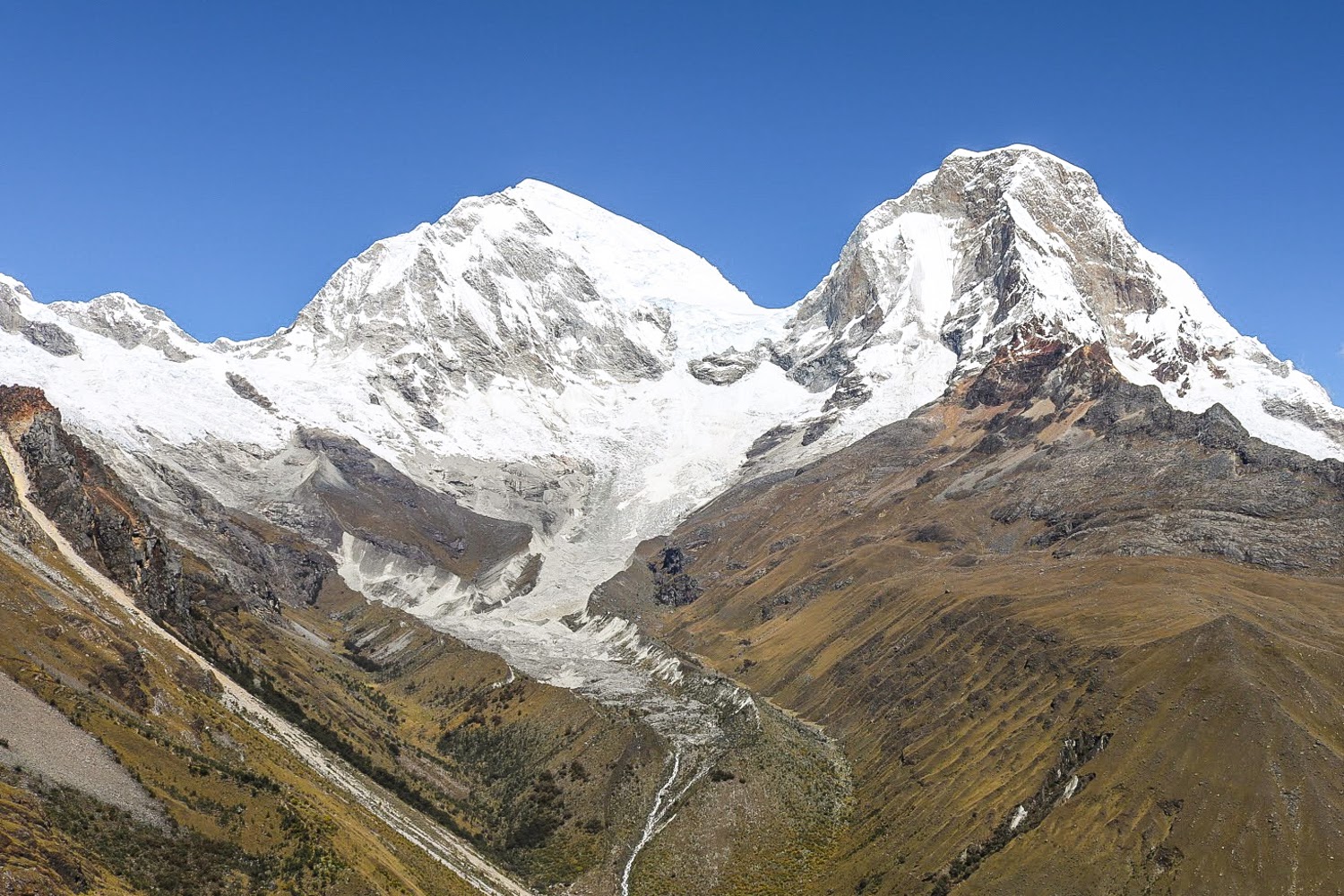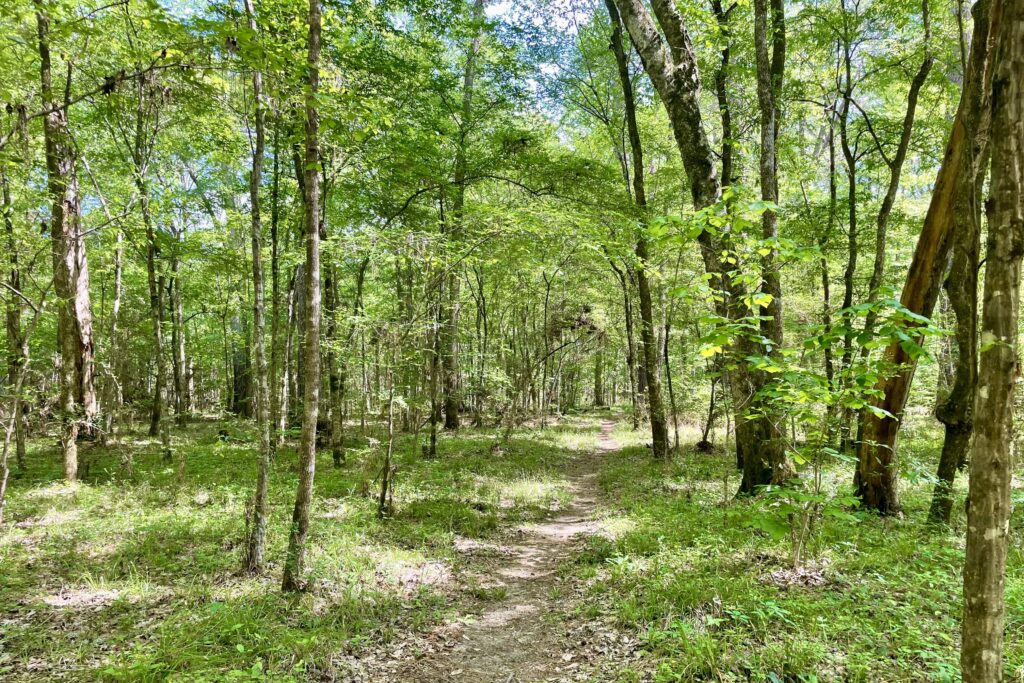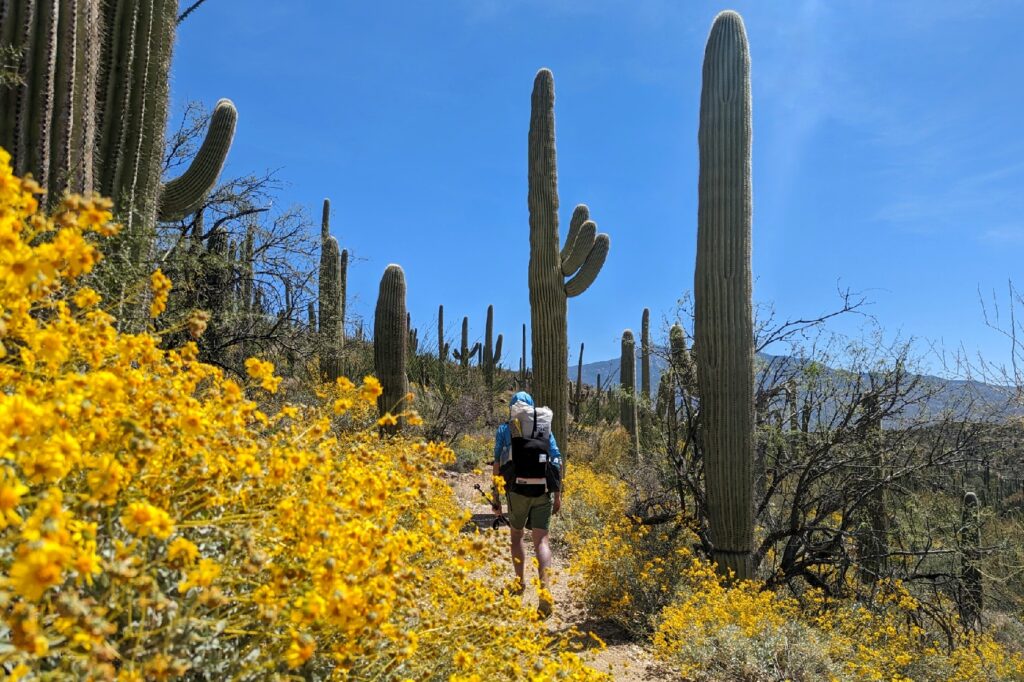
Nestled in the white-peaked Cordillera Blanca range in the Andes, the classic 4-day Santa Cruz backpacking trip may be one of the most beautiful treks in the world. While many people flock to the trails near Machu Picchu, this overlooked hiking mecca north of Lima has a fraction of the visitors, offering relative solitude for such a spectacular place. This trek winds its way through the valleys of the Cordillera Blancas while passing beautiful turquoise lakes on its way to the highest point on the trek, Punta Union.Whether you go independently or with a trekking company, this trek will leave you craving more for what this area has to offer.
Quick Facts
- Distance: 50 kilometers / 31 miles
- Days Needed: 3-4
- Highest Elevation Reached: 4760m/15,617ft (Punta Union pass)
- Best Travel Time: May to September (dry season)
- Difficulty: Moderate-Difficult
- Closest Town: Huaraz
- Note: Can complete independently or with a guide
Best Time to Travel
Although people trek year round in this region, the best time to hike is May to mid-September when the weather is generally good and the mountains are clear. Hiking outside this peak season will bring much more solitude, but the weather is also more inconsistent. As always, make sure you check local weather conditions before you set out and be diligent in monitoring current conditions, as weather can change quickly in the mountains.
Difficulty
- Total Distance: 50 km / 31 miles
- Beginning elevation: Vaqueria (3700m/12,139ft) or Chashapampa (2900m/9,514ft)
- Highest elevation: 4,760m/15,617ft
- Overall Difficulty: Moderate-Difficult
As always, difficulty ratings depend on your experience, physical fitness, pack weight, & weather conditions. Each day you will be hiking for roughly 6-8 hours with moderate to significant elevation gain, depending on the day. If you are hiking with a guide or have a donkey to help carry some of your gear, you will be hiking with much less weight, allowing you to hike longer distances more comfortably.
We highly recommend training before your trek. Put a backpack on and do some day hikes. Get your body ready; do some air squats and lunges to build up leg strength. Know your limitations, brush up on your backpacking skills, and dial in your lightweight gear. Doing so will make for a much more enjoyable trip and can also help with altitude.
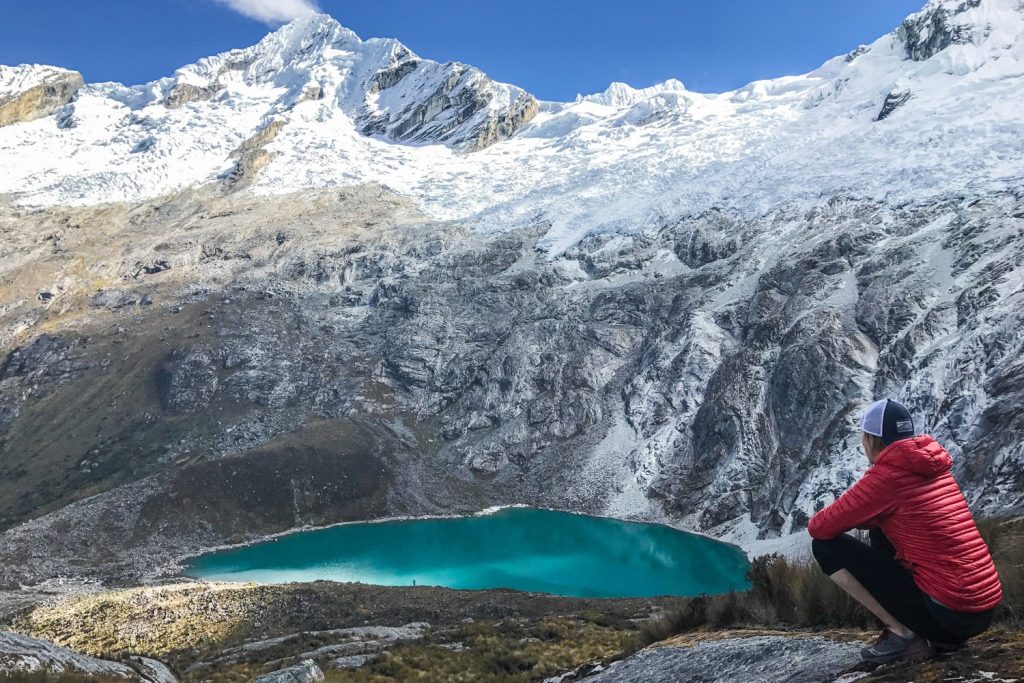
Getting There
Most people traveling to Peru arrive at Jorge Chávez International Airport in Lima. In order to begin the Santa Cruz trek you will need to get to the small mountain town of Huaraz, which lies 400 km north of Lima. You will have two options to get from Lima to Huaraz. You can take a bus, which takes roughly 8 hours and will cost you anywhere from $20-$30 depending on seat selection. We recommend going with either Cruz del Sur or Oltrusa, as they offer the most reliable, comfortable and cleanest buses. Also, you can buy your tickets online ahead of time, which is a rare convenience when traveling by bus internationally. Pro Tip: If taking a night bus, we highly recommend upgrading to a cama suite. Your seat will recline 180 degrees!
Your other transportation option is to fly from Lima to Huaraz, which takes about one hour and will cost anywhere from $85-$150, depending on season.
Visa Information
As of August 2017, you do not need a tourist visa to enter Peru. The maximum stay granted in Peru is 183 days. Please check current visa guidelines for specific information as these policies can change and this website is not an official source of information on Peru visas.
Where to Stay in Huaraz
You should spend 1-2 nights (we recommend 2 nights) in Huaraz prior to your trek in order to properly acclimatize. There are many hotels and guesthouses in all price ranges throughout Huaraz. We enjoyed staying in walking distance from Plaza del Armas, which is a central point in the small city. For around $30-40/night for two people, you can find very nice accommodation with breakfast included. Most hotels and guesthouses will store your larger bags for you while trekking.
We stayed at El Jacal Classic Guesthouse before our trek and were very pleased with the cleanliness and service provided. We arrived to Huaraz very early in the morning on a night bus and they let us hang out in the common area and even fed us breakfast that morning before check-in.
Pro Tip: Plan on spending a night in Huaraz after your trek to shower, relax, and drink a celebratory Pisco Sour with your new trekking friends. We had some people in our group that went straight from the trek to a night bus and they regretted it.

Trekking Cost
If you decide to complete the hike with a trekking company, you can expect to pay anywhere from $150-$300 for the 4-day trek. There’s a wide range in quality of service, so do your research. Usually a higher cost translates to better equipment, guides, food, and overall service. Compared to hiking costs in the areas around Machu Picchu, we felt the costs to hike around Huaraz were very reasonable for what you receive.
In addition to this cost, every trekker will be required to pay 65 Peruvian Soles (~$20 USD) in fees to Parque Nacional Huacarán. You can pay this at the trailhead prior to your trek. Just remember to bring a copy of your passport with you. It’s money well spent as your fee goes to maintain trails, pay park rangers, and continue conservation efforts in this breathtaking region.
Don’t forget to bring some extra cash with you. You may want to buy some treats after your get off the trail. You will also want some cash to tip your hard working guides, cooks, and donkey drivers. The going rate for tipping seems to be right around 10% of your cost, divvied up between all the trekking staff. Many groups pool their tips and give as a group.
Trailheads
There are two possible starting points for this trek and you can complete it in either direction. The most common place to begin is Vaqueria (3,700m), however on our trek we began at Cashapampa (2,900m). The benefit to beginning at Vaqueria is that it is less total elevation gain than beginning at Cashapampa.Also, if you are trekking independently, it is easier to finish at Cashapampa as there are more transportation options back to Huaraz. If beginning in Cashapampa, your first day is a hot and grueling climb up a dusty trail.
The benefit of beginning your hike in Cashapampa is that you have begin at a lower elevation and have a more gradual ascent to Punto Union, crossing the pass on your third day. For those struggling with altitude, this may be a better option. If properly acclimatized, we recommend starting at Vaqueria, if not, we recommend starting at Cashapampa.
If you are hiking independently, you will use a combination of combis (small buses) and shared taxis to get to the trailhead. It’s cheap and not super complicated to get to the trailheads. Just ask locally for the easiest transportation routes/options.
Regardless of where you choose to begin, there are some incredible side trips that you cannot miss. Either right before or right after you cross Punta Union, there is a side trip to Laguna Arhueycocha that is very worthy of the uphill sludge to get there. Think glaciers feeding into a beautiful turquoise lake surrounded by a amphitheater of peaks.

Independent or Guided Trekking
This is an important question for many trekkers and the choice will likely come down to experience and personal preference. Although we generally enjoy the freedom and flexibility that comes with hiking independently, when you factor in gear logistics, transportation, and the relatively low cost of going with a trekking company, we recommend hiring a guide for this trek. This does not mean you have to sign up for a trekking group with 14 other people. If you like the solitude of a small group, you could even hire your own guide and donkey driver, although your price will be higher.
If you’re a highly experienced backpacker, it is totally possible to complete this trek without a guide. The trail is well-marked and easy to follow.If you plan to hike independently, make sure you have a good map, the right gear, a proper permit, and a good guidebook before you leave Huaraz. Also, expect to put in a good amount of planning time to fully prepare for your hike. You will have to travel to Peru with a full backpacking setup or plan on renting quite a bit of gear in Huaraz. You will also have to carry all your gear, unless you hire a donkey driver.
If you’re unsure of your preparedness or nervous about high altitude safety, we highly recommend hiring a guide.
Guided Trek Pros
- all pre-trip details handled
- all transportation arranged
- little worry about any details while hiking (food, route, schedule, etc.)
- guidance & safety while trekking at high altitude
- local information on region, culture, etc
Independent Trekking Pros
- less expensive
- more flexible schedule
- more choice on where to camp
- no group dynamics to deal with, just you and the trail.
Trekking Companies
If you walk the streets in Huaraz, you will find no shortage of trekking companies. Many people organize their treks before arriving for peace of mind, however if you are on a more flexible schedule you can arrange your trek in Huaraz. After researching our options, we decided to go with the trekking company Eco Ice Peru. Their reviews were fantastic and our pre-trip communication with the owner, Orlando, was phenomenal. Throughout our trek we were constantly impressed with the professionalism and service offered at every turn. The staff was not only diligent in ensuring we had a good time, they were also fun, positive, and always smiling. After driving back to Huaraz on our last day we were invited to the house of Orlando’s mother and she served us a phenomenal feast with pisco sours. It was a lovely way to celebrate with our new friends.

Water
There are plentiful water sources along the way, however it is imperative that you either boil or treat your water to ensure it is safe to drink.
If you are hiking with a trekking company, water will be provided for you every day on the trail. Every morning your crew will boil water and fill up your bottles for the day. We recommend bringing two 1L plastic water bottles per person. In addition, you will be provided with tea and other hot beverages at every meal time. Coca tea, which can help with symptoms of altitude sickness, will almost always be an option.
If you are hiking independently, we recommend bringing a SteriPEN Ultra as your water purification method. It is fast, easy to use, and you don’t have to ingest any chemicals. We also like the Sawyer Squeeze, as it’s incredibly lightweight, but the squeezing can become tedious. Aquamira Chemical Drops are also another good purification method, but they require time (30min – 4 hours) for purifying.
Remember: Staying hydrated is essential while trekking and it becomes increasingly important as you hike higher in elevation. Drink up!
Food
If you are hiking with a trekking company, you will have all your meals provided, including a daily snack bag (chocolate, cookies, fruit, etc) and a tea time every afternoon which usually had delicious appetizers. The meals that we had on our trek were some of the best we had in Peru. Our dinners were often 3-4 course affairs, always including soup, several main courses, and dessert. It was amazing what the chefs would cook over a propane stove. We ate all our meals in a large tent, with a table and stools, a wild luxury on a wilderness trek.
The quality and quantity of food can vary between companies so ensure you do your research before selecting a company to go with. Eco Ice Peru was exceptional and we would highly recommend them.
If you are hiking independently, you will need to plan all your meals and carry your food and cooking system. For backcountry meals we usually focus on dehydrated foods like Mountain House, instant mashed potatoes, instant pasta, tuna/chicken packets, cured meats and hard cheese, and oatmeal, to name a few. One of our favorite fool-proof cooking systems is the JetBoil Mini Mo, which allow you to quickly boil water for meals and hot beverages.
For more information on food and meals in the backcountry, check out our video on Ultralight Backpacking Food.
Personal Hygiene
The Santa Cruz trek is a true wilderness trek so you should be prepared to get down and dirty. Some of the trekking companies provide a small bucket of hot water each day after hiking. However, we found that the best way to feel relatively clean was to pack a supply of body wipes. It’s amazing what a game changer this “shower” can be at the end of an arduous day of hiking.
Also, do not head out on the trail before picking up some alcohol-based hand sanitizer. Keep it in a handy place and use it before any snacks or meals.
Many of the trekking companies will put up a temporary toilet tent at your site every night. This is basically a small one-person tent with a dug-out hole for doing your thing. It’s not glamorous, but it ensures that human waste is disposed of responsibly and in a contained manner. Make sure that you carry toilet paper with you throughout the trek, as this is not always provided by your trekking company. As always, it is imperative that you Leave No Trace while trekking. Let’s help keep this place beautiful.
Bugs
Mosquitoes and biting flies are present and can be incredibly obnoxious at lower elevations. Use a combination of permethrin on your clothing and a small amount of DEET on exposed skin for full protection. Luckily, bugs were only really an issue on the first and last days of the trek for us.

Travel Insurance
We highly recommend purchasing travel insurance if you plan to trek in Peru.Most trekking locations in Peru are very remote, so if something goes wrong, you’re likely to need an emergency evacuation and that can get insanely expensive.
When choosing travel insurance, make sure to buy a plan that will cover high altitude trekking and helicopter evacuations, just in case. We did a bunch of research and ended up choosing World Nomads for our treks. Their rates were reasonable, their coverage met our needs, and communicating with them was easy. We fortunately didn’t need to use our travel insurance, but the peace of mind alone was well worth it.
Trekking Safety
When hiking in Peru, you’ll be heading into remote areas far from reliable hospitals. If hiking with a trekking company, they will be carrying a basic first aid kit.If trekking independently, it’s important to take every precaution before you set out. Here’s a tutorial video we created to help you brush up on emergency first aid skills.
- Educate yourself on acute mountain sickness (AMS – more info below). Take the prescribed acclimatization days, stay hydrated, and listen to your body.
- We recommend buying travel insurance before you trek to ensure that if any emergency evacuations or procedures need to be completed, you are covered.
- Don’t trek alone. If you’re traveling solo, consider hiring a guide or making friends to hike with.
- Always pay close attention to weather conditions, especially on the long pass day. Storms can develop quickly in the mountains and can be fatal if you’re not prepared.
- Always hike with a lightweight first-aid kit and the 10 backpacking essentials.
- Leave a detailed itinerary with an emergency contact and write important phone numbers on a piece of paper that will be easy to find in an emergency.
- When encountering donkeys or mules on the trail, move to the inside (away from any cliff) and let them pass.
- Crime is not common while hiking in Peru, but it’s not unheard of either. Keep a close eye on your belongings, especially your backpack filled with valuables.
- Always carry enough water on the trail and stay hydrated.
- Keep your eyes on the trail to avoid any misstep that could end your trek.
High Altitude Safety
It’s important to know the basics of high altitude hiking. Acute Mountain Sickness (AMS) is no joke, and if you make reckless decisions or ignore symptoms, it could even kill you. Most people that take the time to acclimatize properly experience limited AMS symptoms, if any, so there’s no need to freak out. But you do want to understand AMS and take it seriously. Learn more about high altitude safety with this tutorial video we created.
Although this trek has a gradual ascent, you will be hitting an elevation of 15,617 ft (4,670m), which is significant for the average hiker. Many people coming to Peru are arriving from near sea level and will need to take a few days in Huaraz (10,013 ft/3,052m) to acclimatize prior to heading out on the Santa Cruz Trek. It’s recommended that you go on several day hikes to prepare. The day hikes around Huaraz will most likely be some of the most beautiful day hikes you’ve ever done. Some recommended acclimatization hikes in the area are: Laguna 69, Laguna Wilcacocha and Laguna Churup.
Maps and Guidebooks
- Lonely Planet Peru – For general trip planning and research, we highly recommend picking up this book. There’s good information about the Cordillera Blanca region, including the Santa Cruz trek, day hikes around Huaraz and general information on Huaraz. And I’m sure you didn’t come to Peru just to hike in the north. It’s the travel bible. Pick one up.
- Peru’s Cordillera Blanca and Huayhuash: The Hiking and Biking Guide – This book is a great resource written by people who’ve actually hiked and biked these trails. If you chose to trek independently, this is a resource you should definitely consider purchasing. It covers the Santa Cruz and Huayhuash treks extensively, but also offers great information on lesser known treks in the region.
- Map of Santa Cruz Trek (From Cashapampa to Vaqueria) – This is a somewhat basic map of the area that will give you a general outline of the trek. You will want to find a more detailed map in Huaraz to take on the trail if you are hiking independently.
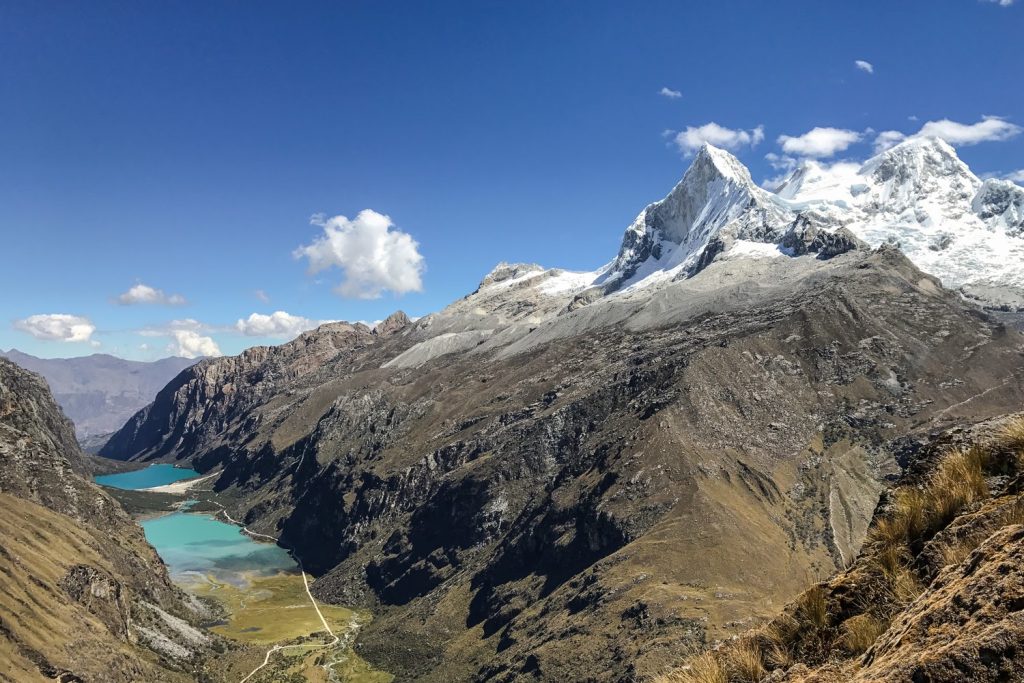
Trekking Gear List
One of the nicest things about trekking in Peru is that it’s accessible for a wide range of travelers. Most of the people that come to Peru to trek do so with a trekking company, which will provide most of the camping and cooking equipment, transportation and food. In most situations you will be provided with a duffle bag the night before you depart for your trek. It varies, but generally you are allowed to fill this bag with 5 kgs (~11 lbs) of gear that will be carried by the donkeys during the day. Because most of your gear is carried by donkeys, you should be carrying a pretty light daypack. That will give you the opportunity to pack light and enjoy your hike. If you’re new to our site, don’t miss out on the CleverHiker Gear Guide, where we break down our favorite tents, sleeping bags, sleeping pads, backpacks, stoves, hammocks, and much more.
DAYPACK – A simple lightweight daypack (20-30 liters) is really all you should need on a supported trek. We used the Osprey Talon 22 Daypack and were incredibly happy with it. It was lightweight, provided the perfect amount of space, and had the comforts of a larger hiking backpack (sturdy hip belt and sternum strap, ventilated back). The items in your daypack will include water, snacks, layers, camera equipment, sun protection, and any other items that you will need accessible throughout the day.
SLEEPING BAG – Although most of your gear is provided by trekking companies, oftentimes you are required to bring your own sleeping bag or rent one from the company. The quality and cleanliness of rented bags can vary significantly so we recommend, if you have the space, bringing your own sleeping bag. The trekking companies recommend a sleeping bag rated in the 10-20 degree range. We used the Feathered Friends Egret UL 20 and REI Magma 10 sleeping bags. They were plenty warm on chilly nights and we enjoyed the comfort of not sleeping in someone else’s filth. Here’s a list of some of our other favorite lightweight sleeping bags.
SLEEPING PAD – If you are trekking with a company, they almost always provide a sleeping pad, but always double check. If not, we recommend a lightweight sleeping pad such as the Therm-a-Rest NeoAir XLite that will keep you warm and ensure a good night’s rest.
SHOES OR BOOTS – We almost always prefer trail runners when hiking. We wore my Saucony Peregrine 7 trail runners, which come in male and female versions, on all of our Peru treks and we’d make the same choice again. If you prefer boots, make sure they’re lightweight and break them in really well before you set off on the trail. Here’s why we prefer to hike in trail running shoes: 5 Reasons to Ditch Your Hiking Boots.
WATER PURIFIER – If hiking with a trekking company, you do not need to worry about bringing a water purifier as you will be provided with boiled water.If hiking independently, we recommend the SteriPEN Ultra. It’s fast, easy, and effective. You’ll also save money and waste a lot less plastic by reusing the same bottles. Purifying tablets are easy to find in Peru, but we prefer not to ingest strange chemicals whenever possible. We picked up some tablets to have as a backup but thankfully didn’t end up needing them.
CLOTHING – Don’t overpack on clothing. That’s a common mistake that will lead to unnecessary weight. Instead, pack in layers and avoid bringing any two items that will serve the same purpose. Here’s what we brought with links to some of our favorite gear:
- 1 Rain jacket shell – Patagonia M10
- 1 Pair rain pants – Mountain Hardwear Stretch Ozonic
- 1 Down jacket – Patagonia Ultralight Down Hoody
- 1 Fleece jacket – Extra warmth under your down jacket that will be warmer when damp and better to hike in.
- 1 Pair hiking pants / running tights
- 1 Pair hiking shorts – Nike dri fit running shorts
- 1-2 Hiking t-shirts – Nike dri fit t-shirts
- 1 Long-sleeve shirt – Nike dri fit quarter zip
- 1-3 Pair underwear – ExOfficio boxer briefs or ExOfficio women’s briefs
- 2-3 Pair socks (add thin sock liners if using boots) – Balega running socks for warm weather & SmartWool mountaineer socks for snow.
- 1 Pair long john bottoms – long john top optional for nighttime use.
- 1 Warm hat
- 1 Sun hat
- 1 Pair gloves or mittens
MAP, COMPASS & GUIDEBOOK – You can find a trekking map in Huaraz, as well as in the guidebooks. We always hike with a compass too, though the trails were easy to follow and we didn’t end up needing it. For a guidebook, we found the Lonely Planet Peru to be very useful.
FIRST-AID KIT – Always bring a small personalized first aid kit. We used the .5 Ultralight Kit and added extras, like painkillers, diamox, and personal medications.
SUN PROTECTION – Sunglasses (polarized recommended), sunscreen, and spf lip balm are an absolute must.
HEADLAMP – A small headlamp like the Petzl Actik will be useful for late night bathroom visits.
POCKET KNIFE – We brought along a small Swiss Army Knife which came in handy here and there. This should be considered optional, but we like to hike with one.
PACK COVER – We don’t hike with pack covers because they don’t provide full rain protection. We use a combination of waterproof stuff sacks and a sturdy trash bag liner inside our packs. That gives us 100% rain protection, even in a downpour. Ziploc bags also come in handy.
TREKKING POLES (optional) – We don’t usually hike with trekking poles, but many hikers in Peru do. If you have bad knees/ankles they can help reduce strain on big ascents and descents. We didn’t bring them on any of our treks in Peru and didn’t miss them at all.
OTHER ITEMS
- SMALL TOWEL – the Nano pack towel is great.
- CASH and COPY OF PASSPORT
- PERSONAL TOILETRIES
- HAND SANITIZER – Use hand sanitizer often (especially before meals) and you’ll have a better chance of avoiding illness.
- WET WIPES – These are very useful for cleaning up after hiking, especially when it’s too cold for a shower.
- INSECT REPELLENT – At higher elevations insects aren’t a problem at all. For lower elevations, 30% DEET will do the trick.
- BIODEGRADABLE SOAP – A small bottle of Campsuds can be useful for washing up and cleaning clothes.
- TOILET PAPER – Most trekking companies won’t provide any, so you’ll want to bring your own.
- GEAR REPAIR TAPE – Tenacious Tape is great for many different issues that may arise.
- CAMERA – The Sony RX100 is our go-to camera for backpacking.
- POWER BANK – We kept all our electronic devices charged with a power bank. The batteries on your phone and camera will drain more quickly at high altitude, so it’s essential to have a backup power source.
- GAMES, BOOKS & JOURNAL – There can be some afternoon downtime when hiking in Peru, so make sure to bring lightweight entertainment. We loved having our Kindle Paperwhites with us. We also played cards, worked on crossword puzzles, and wrote in our journals often.
- SNACKS – Don’t overdo it, as your trekking company will be giving you a daily snack bag. That said, having a few luxury snacks can be nice. We’re big fans of a daily Snickers on the trail.
- EAR PLUGS – You may have a snorer in your group, so we always travel with a lightweight pair of ear plugs. They are also great if you are taking any long bus rides.
- WATER BOTTLES – We hiked with two 1L plastic water bottles each. They’re cheap, strong, they work well with the SteriPEN, and they’re easily replaceable. Water sources are plentiful along trails and we rarely needed to hike with more than 1-2L each.
INDEPENDENT HIKING GEAR
If you are heading out on the Santa Cruz independently then you are a probably an experienced backpacker and are aware of your gear requirements for multi-day treks into the mountains. That being said, there is a good amount of elevation gain on this trip so it is imperative to keep your pack weight to a minimum. We prefer lightweight backpacking because it’s more comfortable and it allows us to cover more ground with less effort. It makes the hiking a lot more fun and trip logistics a lot easier. But we don’t like giving up camp comforts either. We hike with lightweight shelters, plush sleeping pads, cozy sleeping bags, and all the other camp comforts everyone wants. For recommendations on our favorite lightweight backpacking equipment, check out the CleverHiker Gear Guide and our Top Gear Picks page.

Responsible Trekking & Cultural Considerations
The number one rule of backpacking is Leave No Trace. Learn it and live it.
Don’t litter. Pack out your trash and keep Peru beautiful for generations to come. If you really want to be a superstar, pack out trash that you find along the trail.
Dispose of human waste properly (dig a hole 6-8 inches deep, fill it back up when finished, and carry out your toilet paper).
Dress conservatively, especially in towns. For women, this may mean hiking in long pants rather than short shorts.
Always ask permission before taking a photo of a person. Most people won’t mind, but if they decline, respect their wishes.


